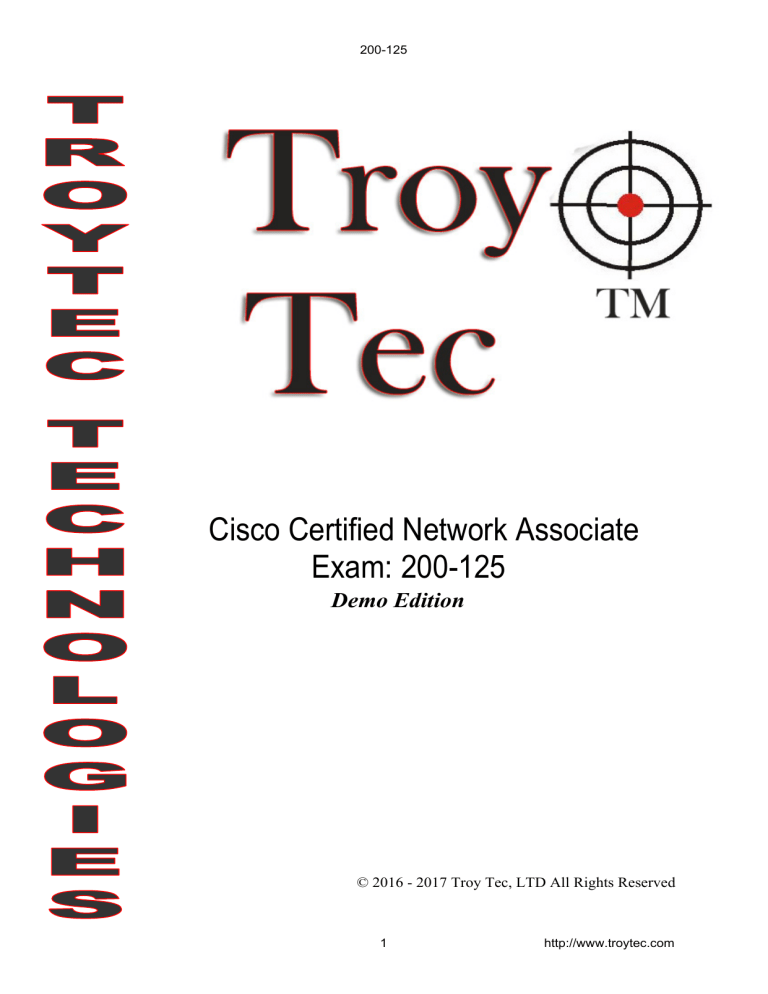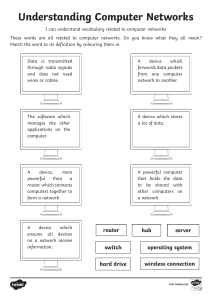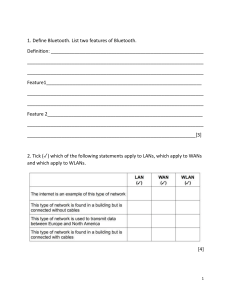
200-125 Cisco Certified Network Associate Exam: 200-125 Demo Edition © 2016 - 2017 Troy Tec, LTD All Rights Reserved 1 http://www.troytec.com 200-125 QUESTION: 1 Where does routing occur within the DoD TCP/IP reference model? A. application B. internet C. network D. transport Answer: B QUESTION: 2 Which of the following correctly describe steps in the OSI data encapsulation process? (Choose two.) A. The transport layer divides a data stream into segments and may add reliability and flow control information. B. The data link layer adds physical source and destination addresses and an FCS to the segment. C. Packets are created when the network layer encapsulates a frame with source and destination host addresses and protocol-related control information. D. Packets are created when the network layer adds Layer 3 addresses and control information to a segment. E. The presentation layer translates bits into voltages for transmission across the physical link. Answer: A, D QUESTION: 3 Refer to the exhibit: 2 http://www.troytec.com 200-125 What will Router1 do when it receives the data frame shown? (Choose three.) A. Router1 will strip off the source MAC address and replace it with the MAC address 0000.0c36.6965. B. Router1 will strip off the source IP address and replace it with the IP address 192.168.40.1. C. Router1 will strip off the destination MAC address and replace it with the MAC address 0000.0c07.4320. D. Router1 will strip off the destination IP address and replace it with the IP address of 192.168.40.1. E. Router1 will forward the data packet out interface FastEthernet0/1. F. Router1 will forward the data packet out interface FastEthernet0/2. Answer: A, C, F QUESTION: 4 DRAG DROP Drag the cable type on the left to the purpose for which it is best suited on the right. (Not all options are used.) Answer: Exhibit 3 http://www.troytec.com 200-125 QUESTION: 5 Refer to the graphic. Host A is communicating with the server. What will be the source MAC address of the frames received by Host A from the server? A. the MAC address of router interface e0 B. the MAC address of router interface e1 C. the MAC address of the server network interface D. the MAC address of host A Answer: A QUESTION: 6 Which of the following statements describe the network shown in the graphic? (Choose two.) 4 http://www.troytec.com 200-125 A. There are two broadcast domains in the network. B. There are four broadcast domains in the network. C. There are six broadcast domains in the network. D. There are four collision domains in the network. E. There are five collision domains in the network. F. There are seven collision domains in the network. Answer: A, F QUESTION: 7 Refer to the exhibit. Host A pings interface S0/0 on router 3. What is the TTL value for that ping? 5 http://www.troytec.com 200-125 A. 252 B. 253 C. 254 D. 255 Answer: B QUESTION: 8 Host 1 is trying to communicate with Host 2. The e0 interface on Router C is down. Which of the following are true? (Choose two.) A. Router C will use ICMP to inform Host 1 that Host 2 cannot be reached. B. Router C will use ICMP to inform Router B that Host 2 cannot be reached. C. Router C will use ICMP to inform Host 1, Router A, and Router B that Host 2 cannot be reached. D. Router C will send a Destination Unreachable message type. E. Router C will send a Router Selection message type. F. Router C will send a Source Quench message type. Answer: A, D QUESTION: 9 What is the difference between a CSU/DSU and a modem? A. A CSU/DSU converts analog signals from a router to a leased line; a modem converts analog signals from a router to a leased line. B. A CSU/DSU converts analog signals from a router to a phone line; a modem converts digital signals from a router to a leased line. C. A CSU/DSU converts digital signals from a router to a phone line; a modem converts analog signals from a router to a phone line. 6 http://www.troytec.com 200-125 D. A CSU/DSU converts digital signals from a router to a leased line; a modem converts digital signals from a router to a phone line. Answer: D QUESTION: 10 A receiving host computes the checksum on a frame and determines that the frame is damaged. The frame is then discarded. At which OSI layer did this happen? A. session B. transport C. network D. data link E. physical Answer: D QUESTION: 11 A network administrator is verifying the configuration of a newly installed host by establishing an FTP connection to a remote server. What is the highest layer of the protocol stack that the network administrator is using for this operation? A. application B. presentation C. session D. transport E. internet F. data link Answer: A QUESTION: 12 Refer to the exhibit. 7 http://www.troytec.com 200-125 What two results would occur if the hub were to be replaced with a switch that is configured with one Ethernet VLAN? (Choose two.) A. The number of collision domains would remain the same. B. The number of collision domains would decrease. C. The number of collision domains would increase. D. The number of broadcast domains would remain the same. E. The number of broadcast domains would decrease. F. The number of broadcast domains would increase. Answer: C, D QUESTION: 13 For what two purposes does the Ethernet protocol use physical addresses? (Choose two.) A. to uniquely identify devices at Layer 2 B. to allow communication with devices on a different network C. to differentiate a Layer 2 frame from a Layer 3 packet D. to establish a priority system to determine which device gets to transmit first E. to allow communication between different devices on the same network F. to allow detection of a remote device when its physical address is unknown Answer: A, E QUESTION: 14 DRAG DROP Refer to the exhibit. PC_1 is sending packets to the FTP server. Consider the packets as they leave RouterA interface Fa0/0 towards RouterB. Drag the correct frame and packet address to their place in the table. 8 http://www.troytec.com 200-125 Answer: Exhibit QUESTION: 15 Refer to the exhibit. 9 http://www.troytec.com 200-125 Which three statements correctly describe Network Device A? (Choose three.) A. With a network wide mask of 255.255.255.128, each interface does not require an IP address. B. With a network wide mask of 255.255.255.128, each interface does require an IP address on a unique IP subnet. C. With a network wide mask of 255.255.255.0, must be a Layer 2 device for the PCs to communicate with each other. D. With a network wide mask of 255.255.255.0, must be a Layer 3 device for the PCs to communicate with each other. E. With a network wide mask of 255.255.254.0, each interface does not require an IP address. Answer: B, D, E QUESTION: 16 A router has two Fast Ethernet interfaces and needs to connect to four VLANs in the local network. How can you accomplish this task, using the fewest physical interfaces and without decreasing network performance? A. Use a hub to connect the four VLANS with a Fast Ethernet interface on the router. B. Add a second router to handle the VLAN traffic. C. Add two more Fast Ethernet interfaces. D. Implement a router-on-a-stick configuration. Answer: D QUESTION: 17 Which of the following describes the roles of devices in a WAN? (Choose three.) 10 http://www.troytec.com 200-125 A. A CSU/DSU terminates a digital local loop. B. A modem terminates a digital local loop. C. A CSU/DSU terminates an analog local loop. D. A modem terminates an analog local loop. E. A router is commonly considered a DTE device. F. A router is commonly considered a DCE device. Answer: A, D, E QUESTION: 18 DRAG DROP Refer to the exhibit. Complete this network diagram by dragging the correct device name or description to the correct location. Not all the names or descriptions will be used. Answer: Exhibit 11 http://www.troytec.com 200-125 QUESTION: 19 In an Ethernet network, under what two scenarios can devices transmit? (Choose two.) A. when they receive a special token B. when there is a carrier C. when they detect no other devices are sending D. when the medium is idle E. when the server grants access Answer: C, D QUESTION: 20 A network interface port has collision detection and carrier sensing enabled on a shared twisted pair network. From this statement, what is known about the network interface port? A. This is a 10 Mb/s switch port. B. This is a 100 Mb/s switch port. C. This is an Ethernet port operating at half duplex. D. This is an Ethernet port operating at full duplex. E. This is a port on a network interface card in a PC. Answer: C 12 http://www.troytec.com


